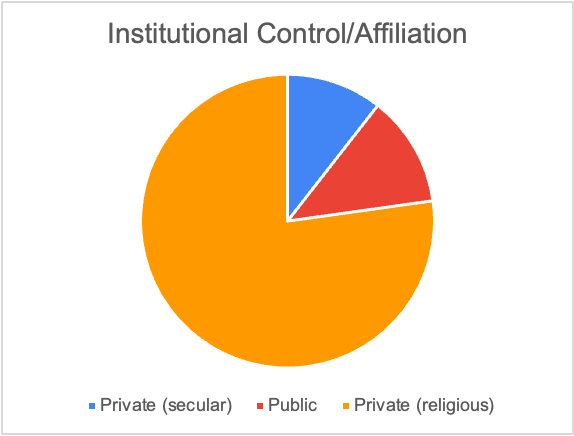Who is the Classic Learning Test for?
In a test-optional era, there's a new college admissions test
You already know what the SAT and ACT are. Maybe you took one or both of them yourself to get into college.
The tests are less ubiquitous than they used to be. Many institutions no longer require them for admission. While some selective institutions are reimposing the requirement (as I’ve written previously), the tests are mostly used as a complement to a college application or as a way to access scholarship funding.
But as testing itself is growing less popular, one college admissions test is increasing in popularity.
Let’s meet the Classic Learning Test.
Trickle Down Examonomics
CLT began in 2015 in Annapolis, MD, not coincidentally the home of the country’s foremost “Great Books College,” St. John’s. Its primary distinguishing feature is detectable from its name; it tests the classics.
This manifests in the reading and language sections where text selections are not the kind of generic or unrecognizable passages found in most standardized tests. Instead, CLT features selections (in translation) of great thinkers across the ages, from Plato and Augustine to Flannery O’Connor and Martin Luther King Jr.
That’s… really it. Just like other tests, it takes about 2 hours. It assesses reading, writing, and math. You can share scores with (some) colleges and earn scholarships based on your score.
Their explicitly stated aim is that by assessing classic texts, schools will be more likely to teach classic texts. This takes “teaching to test” quite literally, hoping to reform American curriculum by shifting its incentives. Instead of students learning to read by analyzing anonymous and forgettable passages, they would instead learn to read with passages that are also beautiful, timeless, and virtuous.
Additionally, CLT offers tests for grades 3-10, intending to cover the same kinds of competencies that are required by most state tests.
I want to focus on the college tests, but the fact that they provide elementary and secondary tests begs the question… who is taking this test?
Classic schools, classic homes
The explicit intention to shift curriculum through testing doesn’t really track for me, considering the fact that no university or state exclusively requires the CLT. Perhaps it’s a long-term goal to take over that space held by state tests and established college admissions assessments. But in the short term, any school that isn’t teaching a classical curriculum can’t be compelled to do so in order to prepare for the CLT.
Instead, it appeals to schools already teaching that way. These are mostly going to be classical schools, which are typically charter schools with a “great books”-inspired curriculum. Or they may be classical Christian schools, which are private schools mixing the same kind of curriculum in a religious environment, typically Catholic or evangelical.
Is that it though? Classic tests for classics schools?
I want to go back to that video I linked to earlier from CLT. When they show their students, what do they looks like? Maybe that can give us a clue about their target demographic.
In discussing the “trickle-down” effect of the test earlier, they show this fairly stereotypical elementary classroom:
What other school images do we see?
When CLT’s CEO says that they want to “lock arms” with anyone who shares their “vision of education,” there are two shots:
He says this is a shared vision that parents can get excited about.

It’s not particularly subtle, but all of these images evoke schooling at home. Perhaps parents are just helping with homework, but the implication appears to me that the test is targeting homeschooling families.
The test itself is administered individually on a device with online proctoring, something that can be done in a school environment or at home. But since the proctoring is functionally individualized, it encourages home testing in a way that not all standardized tests do.
Where do they go to college?
There are some clues, both explicit and implied, from CLT’s advertising. CLT is proud of its growing list of institutions who accept the college admissions test. They list 303 institutions on their website. It’s kind of hard to parse at a glance, but they also list the most popular destinations for their test takers, which may give a better snapshot:
Okay, so it’s about what I would expect. These are a mix of conservative evangelical or Catholic colleges, some of which emphasize a classical curriculum.
And also… University of Central Florida?
Digging in
I decided to go back to the full list and pull some data on those institutions from IPEDS. I ran into some trouble because, of the 303 listed institutions, only 237 had publicly reported data.
I didn’t examine every case, but there appear to be a few reasons for this. Some of the colleges listed are not in the United States, so they have no reason to report student data to the federal government. Some of them are not actually colleges and are, instead, college-like programs or fellowships, or even programs within larger institutions. Some are accredited colleges but they do not accept federal support. Because of that, the federal government cannot compel them to report their student data, so they don’t show up on an IPEDS search. Some of the listed institutions have ceased their operations.
I am not sure why you would tell students they can apply to a college that no longer exists, but maybe they just really want to have “over 300” names on their list.
78% of the institutions that CLT has a relationship with are searchable on IPEDS. What do we find?
Let’s begin with that Florida thing. CLT is way ahead of me and already has a page just for that state.
The simple answer is that the governor of Florida signed a law in 2023. This required all public universities to accept CLT for the same purposes they accept SAT/ACT scores, meaning that it can facilitate admission and scholarships just like any other test.
As a result, there are now 29 public universities nationwide accepting CLT scores. I went ahead and made a handy chart to show how those institutions are distributed geographically:
The only non-Florida options are Christopher Newport University in Virginia, University of New Mexico, and West Texas A&M. Do you think those three universities have ever found themselves as a group for any other reason?
Even so, public universities are a small slice of the pie. In fact, let’s look at another pie:
Over three-quarters of the searchable institutions are religious ones. Even that is an underestimate, as a visual search of the names of the unsearchable schools reveals they are mostly religious programs as well:

We can also look at the size of the colleges. The Carnegie Classifications define institutions with fewer than 3,000 full-time undergraduates as “small.” By that definition, 195 of the 237 institutions in our sample (82%) are small colleges. Half of those “not small” colleges are public universities in Florida.
So, where do they go? Mostly to quite small, quite religious, quite conservative colleges which may also be quite classical.

Exams as individual aesthetics
CLT does not frame itself as a Christian enterprise. In fact, some conservative critics hold that CLT is failing by not being sufficiently focused on Christianity as inseparable from the tradition of Western “great books.”
Whether accidentally or by design, CLT has found itself catering to a niche that sees itself as being definitionally outside the mainstream. Many of the students don’t go to traditional schools, instead being in charter schools or homeschooled. Many of the institutions they apply to are totally off the radar of most college-bound students, so much so that they may not even be accredited.
But the students are still students and the schools are still schools. Testing is just something that happens for schools and students. So, at a minimum, they want a test which matches their preferred philosophy of textual selection.
The ACT and SAT are not likely to go away. State testing is not likely to go away. They are examples of collective enterprises for gathering large scale data, and they’ve found a purpose, even if that purpose is regularly up for debate.
But their scale creates the problem that CLT addresses. In seeking to be usable by everyone, the tests appeal specifically to no one. They don’t stand for anything; they just, kind of, are. If you want your school assessments to stand for something, you can’t look to a universal test.
The CLT is not for everyone, it’s for you. By appealing to the individual and the family, CLT reinforces the “parental control” school of thought in education. School isn’t primarily about building society, it’s about what’s best for your child.
Now, hopefully, education is good for both society and individuals. But CLT is marketing a test for individual families interested in the kinds of individual schools where their individual children will continue on the same path they began at home. The preponderance of small, religious institutions is a reflection of the families who are most interested in a divergent test. Some of the schools are curricularly divergent; most are culturally divergent.
Or at least they’re in Florida.
-Matt
P.S. If you’d like to examine the list of CLT schools for yourself, feel free to peruse my spreadsheet.









